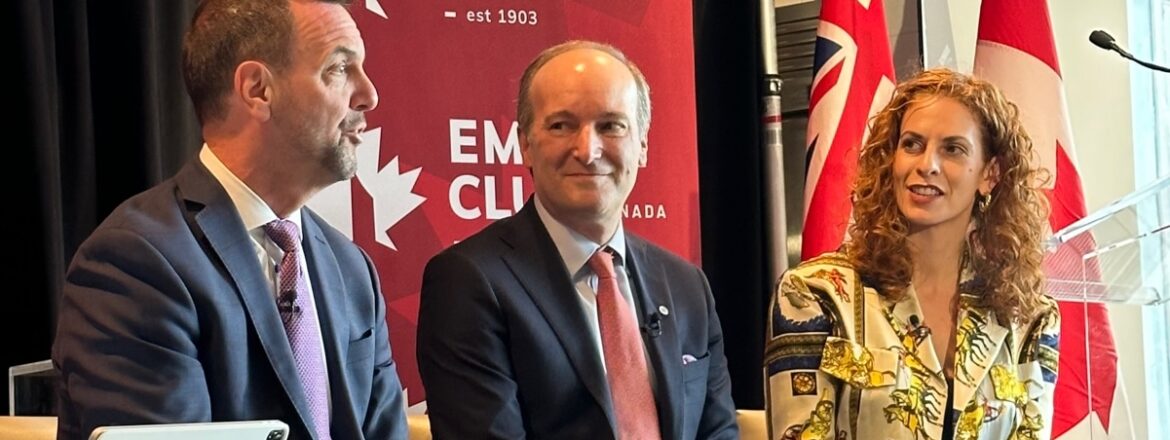There’s no doubt that Canada is currently in the midst of a housing supply crunch. The big question is, what can be done by governments to address it?
The Canada Mortgage and Housing Corporation (CMHC) has estimated that an additional 3.5 million housing units will need to be built by 2030—on top of the 2.3 million units it expects to be built by then—in order to achieve affordable housing for everyone living in Canada.
But with record immigration and housing construction that’s failing to keep pace with demand, that goal appears to be more of a pipe dream.
A recent panel held at the Empire Club of Canada and sponsored by Canadian Mortgage Trends brought together three industry experts who offered some insights and potential solutions to the issue. Participating in the panel were Tim Hudak, CEO of the Ontario Real Estate Association (OREA), Douglas Porter, Chief Economist at BMO, and Lauren van den Berg, President and CEO of Mortgage Professionals Canada (MPC).
Acknowledging the problem
Before talking about solutions, it’s important to first understand some of the reasons why housing supply isn’t meeting demand.
Porter said it has to be acknowledged that some provincial governments, such as Ontario’s for example, are setting “lofty” goals that simply aren’t feasible given the current labour pool.
“Look, there is a hard cap behind on the capacity to build given the amount of skilled labour that we have,” he said, adding it’s been an issue he’s heard talked about for over a decade.
He also noted that the current pace of housing starts in Ontario is “about as high as we’ve ever seen. “I’m concerned that the physical capacity of the building industry really can’t move much beyond that. And, you know, a lot of the lofty goals that we have for home building are not feasible and impossible.”
What are some solutions?
In the case of addressing the skilled labour shortage, Porter said the answer is straightforward: “Train a lot of carpenters, plumbers, electricians, by the dozens.”
Beyond that, Hudak added that changes to the immigration process are also part of the solution.
“The problem with our immigration system is when it comes to homeownership, that it really is biased towards those with university degrees,” he said, adding that the current points-based system focuses more on factors like language, education, business experience, etc.
“That’s great, but we don’t recognize skilled trades with the points system,” Hudak said. “So, how do we change our points system to reward those we’re going to need to build the homes that they’re going to live in?”
Hudak also noted that the largest landowner in Ontario is the government, which puts it in a key position to be part of the solution.
“If government wants to make a difference, whether that’s federal, provincial or municipal, they can put their money where their mouths are and use under-utilized government land and convert it into housing,” he said. “They can build the equivalent of 250,000 homes using city-owned land in Manhattan. Imagine what we could do in the GTA and across the province of Ontario.”
Van den Berg added that there’s a need for a permanent national housing council that would be composed of industry stakeholders, civil society organizations and decision-makers from all three levels of government.
“And the key here is permanent, so it doesn’t ebb and flow with the change of our democracy and electoral systems of parties in power,” she said. “This is a permanent solution to what we hope is not going to be a permanent problem.“
Porter also brought up the idea of converting office buildings into residential units where possible.
“Obviously, we have an issue with the over-supply of office buildings in almost every city centre,” he said, acknowledging certain limitations in terms of feasibility.
Porter said current estimates are that roughly 30% of the current supply of office units could potentially be considered under this proposal. “Insofar as governments can help get some of those converted to residential units, I think that’s a possible area that could help out,” he said.
Governments need to focus
After having spent 21 years in elected office in Ontario, Hudak said it’s taught him that four-year mandates move “awfully fast” and that governments need to “focus all of your horses on a particular task.”
He said Band-Aid policies such as foreign buyer bans or Toronto’s vacant home tax are taking up government resources that should be better spent on larger and more all-encompassing solutions.
“I’d much rather have deployed to getting rid of outdated bylaws that are stopping homes from getting built due to long delays to get subdivision or even an apartment built in your basement to house somebody,” he said. “You really need to focus resources on getting supply built and every shiny bobble is a distraction from that.”
Optimism for the future of Canada’s housing market
Despite the challenges ahead, the panel expressed optimism for the overall future of the housing market and home ownership in Canada.
Hudak said he is “bullish” on housing and reports that his Realtor members are seeing more buyers return to the market and more cases of multiple offers.
“Hopefully now that the cost of homes are rising again we’ll see more supply come into play,” he said. “But over the medium- to long term, there’s such underlying demand in the marketplace. There is an abiding belief among Canadians that homeownership is a good thing. It’s such a part of our culture and the belief in homeownership is stronger than ever.“
Van den Berg said MPC will continue to advocate for measures that will improve affordability, such as increasing the insured mortgage cap to $1.25 million from the current $1 million and calling for the return of 30-year amortizations for CMHC-insured mortgages.
“We’re really committed to bringing the dream of homeownership to life and also making sure that in our advocacy initiatives for all levels of government, we’re pushing to eliminate those barriers to entry,” she said. “Provincially, we’re encouraged by what we see from the [Doug] Ford government to act in terms of its commitments to improve and increase in supply.”


